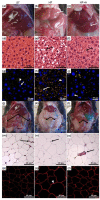Highly Branched Neo-Fructans (Agavins) Attenuate Metabolic Endotoxemia and Low-Grade Inflammation in Association with Gut Microbiota Modulation on High-Fat Diet-Fed Mice
- PMID: 33287102
- PMCID: PMC7761524
- DOI: 10.3390/foods9121792
Highly Branched Neo-Fructans (Agavins) Attenuate Metabolic Endotoxemia and Low-Grade Inflammation in Association with Gut Microbiota Modulation on High-Fat Diet-Fed Mice
Abstract
Highly branched neo-fructans (agavins) are natural prebiotics found in Agave plants, with a large capacity to mitigate the development of obesity and metabolic syndrome. Here, we investigated the impact of agavins intake on gut microbiota modulation and their metabolites as well as their effect on metabolic endotoxemia and low-grade inflammation in mice fed high-fat diet. Mice were fed with a standard diet (ST) and high-fat diet (HF) alone or plus an agavins supplement (HF+A) for ten weeks. Gut microbiota composition, fecal metabolite profiles, lipopolysaccharides (LPS), pro-inflammatory cytokines, and systemic effects were analyzed. Agavins intake induced substantial changes in gut microbiota composition, enriching Bacteroides, Parabacteroides, Prevotella, Allobaculum, and Akkermansia genus (LDA > 3.0). l-leucine, l-valine, uracil, thymine, and some fatty acids were identified as possible biomarkers for this prebiotic supplement. As novel findings, agavins supplementation significantly decreased LPS and pro-inflammatory (IL-1α, IL-1β, and TNF-α; p < 0.05) cytokines levels in portal vein. In addition, lipid droplets content in the liver and adipocytes size also decreased with agavins consumption. In conclusion, agavins supplementation mitigate metabolic endotoxemia and low-grade inflammation in association with gut microbiota regulation and their metabolic products, thus inducing beneficial responses on metabolic disorders in high-fat diet-fed mice.
Keywords: agavins; branched neo-fructans; endotoxemia; metabolites; microbiota; obesity; prebiotics.
Conflict of interest statement
The authors declare no conflict of interest.
Figures






References
LinkOut - more resources
Full Text Sources
Research Materials
Miscellaneous

